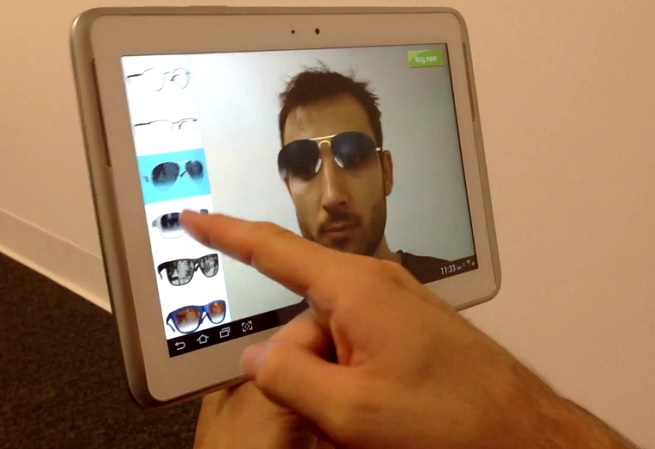If you’re starting a chip company these days, you must take on giant companies. But Movidius is making a place for itself as it takes on ARM, Apple, Samsung, Intel, Qualcomm and others.
The San Mateo, Calif.-based startup is announcing today it raised $16 million in a fourth round of funding to build what it calls a “revolutionary computational image processor chip.” The purpose is to enable eye-popping visual applications on mobile devices that run circles around today’s best-looking apps and games — without killing your device’s battery life.
The company envisions some pretty wild applications for computer vision in the future, as you can see in the video at the bottom.
While most mobile chips use the ARM architecture as a foundation, Movidius is creating its own new architecture for ultralower power, high-performance processing for mobile devices, said Remi El-Ouazzane, the chief executive of Movidius, in an interview with VentureBeat. The effort is extremely ambitious, considering how much work Movidius will have to do in establishing a new ecosystem for its chips.
“We are addressing problems that existing applications processors cannot address,” El-Ouazzane said. “We want to drive the next wave of mobile experiences. Our investors recognize that the innovation in this industry is not necessarily coming from the bigger companies.”
It may sound crazy, but Movidius has a lot going for it. It has raised $50 million to date. Its chairman is Dan Dobberpuhl, who cofounded and sold chip design firm PA Semi to Apple for $278 million in 2008. PA Semi’s technology became the foundation of Apple’s A series chips, which liberated the company from being dependent on the likes of Intel or Samsung for chip designs.
Movidius also has backing from new investors Atlantic Bridge, DFJ Esprit, and Robert Bosch Venture Capital, with participation from existing investors Capital E, AIB Seed Capital Fund, and private investors.
The company was started by three students at Trinity College in Ireland, and it will use the money to develop its products and build its research and development team in Silicon Valley.
The Movidius chip is aimed at new applications that include post-capture refocusing, high-quality zoom, augmented-reality simulation, eye-based user interfaces, gesture controls, advanced location-based services, and modeling and scanning for 3D printing. The company envisions users being able to capture an image, insert it into a scene, and modify it instantaneously.
El-Ouazzane was previously general manager of Texas Instruments’ OMAP application processor division, which TI shut down last fall. But he wasn’t discouraged by TI’s strategic retreat from the smartphone-brain chip business. The lesson from that, he said, was that it is hard to innovate in a big company.
“This new investment allows us to bring our latest computational imaging processor to market early next year, and continue to innovate ground-breaking mobile applications with software partners,” said El-Ouazzane. “Meeting the constant increases in processing power needed to deliver a quality user experience at the right power envelope for advanced mobile applications has required an entirely fresh approach to architecture and not just an incremental enhancement to existing technologies.”
In addition to chairman Dobberpuhl, Movidius’ board will include Brian Long of Atlantic Bridge, Brian Caulfield of DFJ Esprit, and Hongquan Jiang of Robert Bosch Venture Capital. Dobberpuhl previously started SiByte in 1998, a networking chip company that Broadcom bought for $2 billion in stock in 2000. He was also the lead designer of three generations of the Alpha processor built by Digital Equipment Corp.
“This new Movidius computational image-processing architecture opens up completely new possibilities on mobile devices that were once the realm of science fiction,” said Dobberpuhl in a statement. “In the near future, high-performance applications like visual search and 3D-enabled e-commerce using smartphones and tablets with minimal battery drain are within our grasp.”
Movidius plans to partner with mobile device manufacturers. It is not yet announcing any partners. The company has been around since 2006 and it has 50 employees, including a large team in Dublin.
El-Ouazzane said that when he met the team, he fell in love with the design.
“They are able to get to 1 teraflop of performance using only hundreds of milliwatts of power,” he said.
Movidius plans to create a system-on-chip outside of the traditional app processor. It has developed what it believes is a smarter way of capturing images similar to the way that humans see and think. Each pixel has depth, much like humans can see depth with two eyes. Movidius’ computational imaging processor sits between a lens and a sensor.
El-Ouazzane believes that if you get computer vision right, and do it without consuming too much battery power, then you can handle lots of applications with a high level of accuracy.
The architecture captures both hardwired and programmable functions, El-Ouazzane said. It includes a multi-core imaging processing chip that captures images in various lighting conditions, from low light to bright sunlight. It is programmable or computational photography apps that take advantage of multiple sensors and display the depth of each pixel with high-end performance. And it tracks moving objects as they move around in a 3D scene.
Movidius will work with software developers to create cool imaging apps that haven’t been possible before. This year, the company will launch a chip with computational photography features. In 2015 and 2016, it will launch more chips with computer vision features such as 3D modeling, immersive gaming, augmented reality, 3D e-commerce, gesture-based interactivity, facial recognition and others.
The company will focus on high-end devices at first and then bring the technology to mass market devices over time. He isn’t concerned about his big rivals. The company is taping out, or finishing its design, in the near future and will launch in the first half of 2014. The firm is targeting a 28-nanometer manufacturing process.
“When you try to solve a big problem with an existing architecture, you get a linear result,” El-Ouazzane said. “When you work without constraints, you can leap ahead.”


